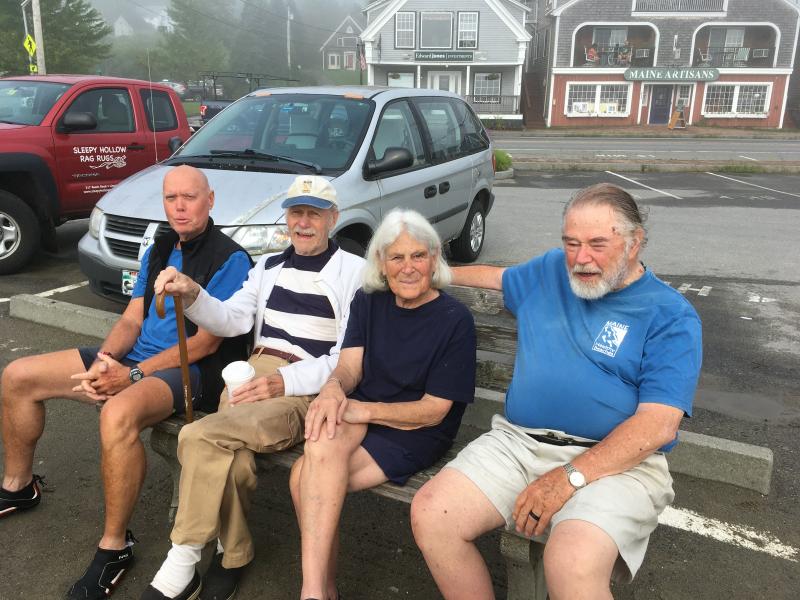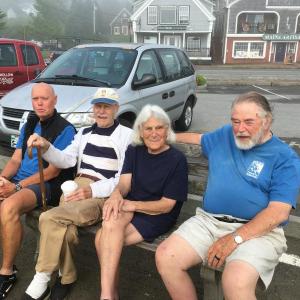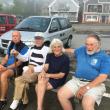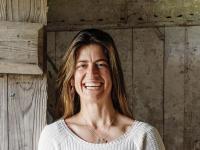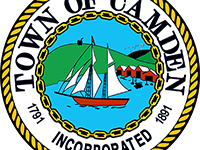This Week in Lincolnville: The Cloud of Witnesses
A small cardboard box, surprisingly heavy, was delivered to my door some years ago. A note inside read: “These World War II soldier photo printing plates were rescued years ago by WWII veteran John Potter. (All were being thrown out by the Republican Journal newspaper.) The 808 blocks have now been given to our Palermo Historical Society and we want to return them to the various towns where these courageous soldiers came from.”
The note was signed Paul Sennett and Miriam Keller, Palermo Historical Society members.
PHS volunteers had sorted the 808 blocks into the various Waldo County towns and delivered them to their respective historical societies. Our box contained 34 little wooden blocks, each about 1.5” x 2.5”, and with a small, metal plate nailed to it. The plate had the engraved image of a young man (and three women) wearing the hat of a soldier or sailor. Think of a black and white negative etched into steel.
The name of each soldier is handwritten on the side:
Edgar Allen
Everett Basford
Richard Callahan
James Carver
Clarence Collemer
Aubrey Connors
Douglas Frohock
Norman L. Gray
Albert Hall
Clarence Hall
William H. Hardy
Elizabeth Heald
Edward Kobs
Harry Marriner
Ella Matthews
Leland McIntyre
David A. Nichols
Donald Patten
Richard Patten
Wylie Patten
Walter Pendleton
Bernard Philbrook
George Porter
Ralph R. Porter
Howard G. Pottle
Malcolm Rankin
Alton Reed
Dorothy Smith
Howard Thomas
Maynard Thurlow
Walter E. Weed
CALENDAR
MONDAY, Sept. 6
Town Office closed for Labor Day
School Committee, 6 p.m., Remote
TUESDAY, Sept. 7
First Day of School!
Library open, 3-6 p.m., 208 Main Street
WEDNESDAY, Sept. 8
Schoolhouse Museum, 1-4 p.m., 33 Beach Road
Library open, 2-5 p.m., 208 Main Street
Planning Board, 7 p.m., Town Office
FRIDAY, Sept. 10
Library open, 9 a.m.-noon, 208 Main Street
Schoolhouse Museum, 1-4 p.m., 33 Beach Road
SATURDAY, Sept. 11
Library open, 9 a.m.-noon, 208 Main Street
EVERY WEEK
AA meetings, Tuesdays & Fridays at noon, Community Building
Lincolnville Community Library, For information call 706-3896.
Schoolhouse Museum open M-W-F or by appointment, 505-5101 or 789-5987
Bayshore Baptist Church, Sunday School for all ages, 9:30 a.m., Worship Service at 11 a.m., Atlantic Highway
United Christian Church, Worship Service 9:30 a.m. outdoors or via Zoom
Aubrey Connors and Maynard Thurlow were killed in action, though the little printing plates don’t foretell that. In fact, as far as I know, none of these men and women are alive today. I knew or remember 10 of them. Most likely if you live in Lincolnville and are of a certain age, a very old age, you remember most of them. Even if you’re new in town you’ll see familiar last names.
Our Historical Society records show that 101 men and 6 women from Lincolnville served in World War II, so these 34 are just a third of the total. 107 out of a population of 892 in 1940. Better than 10% of the population had signed up or been drafted and gone to war.
Meanwhile, the 90% left in Lincolnville kept busy defending the town. This, from Staying Put in Lincolnville, Maine 1900-1950:
“Every night, just after dark, Raymond Oxton drove the length of the Atlantic Highway, from Bullock’s Hill at the Northport line to the Camden line, illuminated by just his parking lights. Raymond was a Civil Defense warden, and he was checking on his neighbors. All windows facing the Bay had to have blackout shades in place after dark. If he found so much as a sliver of light showing he’d stop the car and knock on the violator’s door. The blackout was serious business during the war years in Lincolnville. Like all Civil Defense wardens Raymond was trained to watch out for suspicious activity and/or persons and to report it immediately.
“On the other side of town at 10 Collemer Road, Eileen Young dropped what she was doing whenever she heard a plane approach and ran outdoors. She scanned the sky until she spotted the aircraft, then matched its silhouette to a Civil Defense guide she carried with her. Next she phoned the Civil Defense office to report what kind of plane it was, what time and the direction it was flying.
“A program to train English pilots caused local poultry farmers, including Eileen and her husband, Bradford, a real headache. The pilots were learning to fly low over a target, and those planes roaring overhead panicked the hens in everybody’s barns. The birds would pile up in the corners and could suffocate. After enough complaints the pilots were sent to a higher altitude.
“Bessie Dean was the busy mother of three young children during the war years, but she was a Civil Defense volunteer as well. Bessie learned to drive an ambulance and to administer first aid. She trained regularly to respond in case the town was attacked. Large, hand-cranked sirens were stationed at strategic points around town. The children in the Youngtown neighborhood were frightened by the eerie sound whenever Clyde Young tested the siren at 367 Youngtown Road.
“An attack on Lincolnville wasn’t as unlikely as it seems from this distance and with the benefit of hindsight. In fact, because of its location on Penobscot Bay the town was as likely a target as any on the coast, probably not for attack, but as a landing place for German nationals bent on espionage and sabotage.
“A well-known incident at Hancock Point near Mount Desert Island in 1944 involved the landing of two German agents from a U-boat, sent to spy on the American armaments industry. The men were eventually captured after taking a taxi to Bangor, then making it all the way to New York City by train.
“One story that has been told and retold by a number of Lincolnville people concerns the possible sinking of a German submarine in the waters between Islesboro and the mainland. The details are these:
“One day, early in the war, three planes were heading up the Bay. Suddenly, one of them swung down over Knights’ Point (or the north end of Warren Island—accounts differ), there were several little spatters of water followed by a giant wall of water so large it obscured the island behind it.
“Raymond Oxton was standing at the corner of the Ferry Road and Atlantic Highway while his friend and fellow Civil Defense warden Ray Conley was clamming out on the flats. Raymond never heard a sound; it was “as if everything shut off”, while his friend saw three depth charges drop down from the plane.
“Margaretta Thurlow recalls hearing explosions, and Lucille Masalin remembers a quantity of dead fish washing up at Ducktrap at the time. Keryn Laite was a little boy with his family down on the shore at the State Park in Camden, and he saw the splashes of the depth charges. The next day a cryptic item in the Bangor Daily News reported that a photographic mission sighted and sunk a German submarine on the Atlantic seaboard.
“So was a submarine sunk off Lincolnville that day? To date nobody has offered any concrete proof, such as a part of the craft. Mac Carver, who was coming home that day from Maine Maritime Academy where he was a student, has a different theory.
“He saw the planes and the splash but doubts there was a sinking. He speculates that the depth charges missed the sub, but succeeded in scaring it out of there in a hurry. [Malcolm’s theory makes the most sense, since in the nearly 80 years that have passed, no fisherman has ever reported anything like a submarine on the bottom of the Bay] The flashing lights that Jennie Morse saw from her bedroom window on Youngtown Road fits in plausibly with German submarines in Penobscot Bay. A light on Masalin Mountain could be seen far out on the water
“Perhaps another researcher can delve deeper into the mystery. Military records must exist pertaining to the incident whatever it was. But most of the people who witnessed it are convinced they saw a U.S. aircraft sink a German U-boat right before their eyes.”
Can it happen again? Can we possibly come together again as a community, as a country for a common cause? Some 12% of us out on the front lines, while the rest of us act as support?
There’s no shortage of causes in 2021. Perhaps the most immediate one is the pandemic. At the rate we’re going, maybe this one will end in herd immunity or by a gradual awakening of the anti-vaxxers to what medical experts have been telling us all along, as more of them sicken and even die.
Boy, that’s not only cynical, but heartless. What is it about this situation that brings out the worst in all of us? Me included.
With the vitriol, misinformation, and despair on both sides, this one doesn’t bode well for a community common cause.
I’m betting on climate change as our World War II. Many of the same elements need to come together. Rationing by changing many of our habits – fossil fuel use, wasteful packaging, overabundance of stuff in general. New technologies such as electric vehicles, wind and solar power.
Lincolnville has already taken some steps with our municipal solar array and Library panels. A solar farm is in the works for a Searsmont Road site. Watching shoppers again coming into Hannaford’s with their own bags is heartening. The electric charging station at the General Store is a welcome glimpse into the future.
Surely we’re all witnessing, even experiencing, the effects of climate change already. Winter already seems a thing of the past, or at least winter as most of us remember, when the ponds froze solidly until March or April, the snow pack was so deep we had to put out stakes to mark our driveways, and cross-country skiing was a breeze through the woods. The only respite from the cold and snow came for those few days after Christmas we all told each other was the “January thaw”.
The last ten years or so any random day or days between December and March could qualify as the “thaw”.
I personally know several people who’ve been directly impacted: my Louisiana sister, forced to evacuate from her vulnerable town as Hurricane Ida bore down; the young couple who watched their Vermont homestead slip away down a 100-foot-deep ravine after 10 inches of rain in a day; and northern California friends, two living in the midst of last year’s (or was it two years ago) Napa fires – one saw her home burn down and the other’s vineyard narrowly escaped. Don’s son reports that his favorite Lake Taho ski area is on fire, homes burning down.
Tally up your own acquaintances. How many relatives and friends, how many places you’ve lived or visited have been ravished by the wild weather events of recent years? Weather events that are increasingly considered caused by human activity.
It’s scary stuff, as scary as a world war was for our parents and grandparents. Who will be the heroes? How will our grandchildren remember what we did? And, by the way, what can we do?
Maine Healthy Beaches
Thanks to the dedication of the four pictured above (Rick Smith, Richard Glock, Corelyn Senn, and Bob Olson) a weekly sample of the water at the Beach is sent to the Maine Healthy Beaches Program to monitor the water quality and protect public health. A sign posted at the Beach indicates if the water is safe to swim in; the sign changes if necessary. If the tide is dead low, the team has quite a walk out over the flats to reach the water. The four have been at it for many summers; this photo was taken on their last day for this year. Thanks for doing this!!
Lincolnville Historical Society
The images on the WWII printing plates are elusive, changing as you tip them this way and that. Perhaps there’s a way to print some of them again or at least get a recognizable image. The LHS hopes to have them on display by next summer when, if all goes well, we’ll have a newly-renovated Beach Schoolhouse to show off.
Work has already begun on the second-floor structural support system with part of the downstairs ceiling torn down, revealing the old floor joists. Andy Young reports finding charring, on some of them. With no nearby fire damage on the second floor, it appears these timbers were recycled from an older structure that did have a fire. Those of us who live in an old house will find that familiar; mine for instance, is built with hand-hewn timbers that have marks of plaster and lath where there are no walls, and mortices that have no tenon. Our forefathers wasted nothing.
A recent generous donation of $2500 brings our construction account close to $100,000! Thank you to all who have made donations and bought our take-out meals last winter. With roofing, foundation, siding work and painting still to be done, not to mention some inside renovations – an ADA bathroom, climate controlled storage, etc., we’re still looking towards our goal of $325,000. That’s half as much as the town’s estimate to bring our old building into the 21st century.
Go to the Lincolnville Historical Society website to donate.
Event Date
Address
United States

